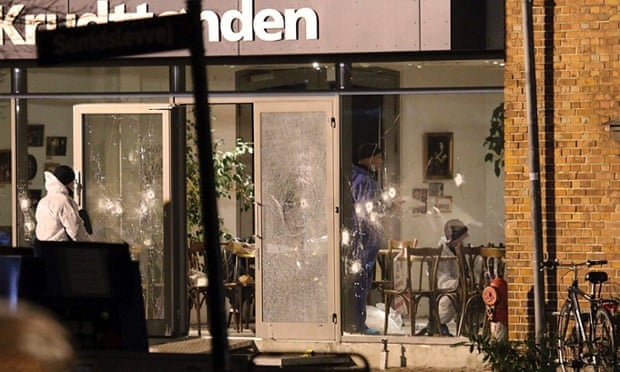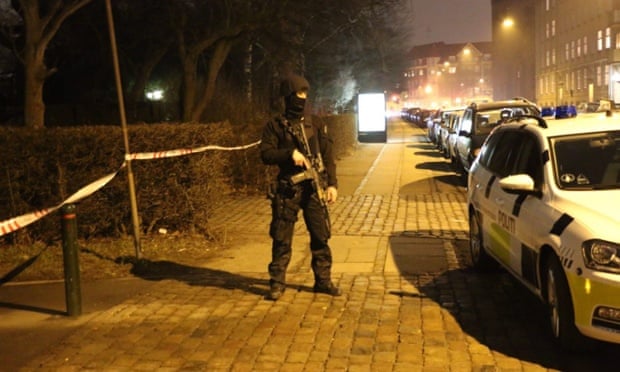The gunman shot dead by police on Sunday after a double terror attack on a cafe and synagogue in Copenhagen that claimed two lives was known to Danish intelligence, the head of the country’s security service has said.
Jens Madsen said the killer may have been “inspired by militant Islamist propaganda issued by IS [Islamic State] and other terror organisations”, but it was not yet known whether he had travelled to Iraq or Syria before the attacks.
The suspect was from Copenhagen but has not been named. He had been “on the radar” of the intelligence services, police said. They have recovered a weapon believed to have been used in the first attack.
The killings began at about 3.30pm local time on Saturday, when a man attacked the Krudttønden cafe during a debate featuring the controversial Swedish artist Lars Vilks, who had depicted the prophet Muhammad in cartoons. Finn Nørgaard, 55, a film director attending the event, was reportedly shot dead at close range after going outside for an unknown reason at the time the attacker struck.
At about 1am, 37-year-old Dan Uzan was killed while guarding the synagogue in Krystalgade during a bat mitzvah celebration. Two police officers were also hit, but their injuries were said not to be life-threatening.
The Danish prime minister, Helle Thorning-Schmidt, condemned what she called “a cynical act of terror” and said she was “happy and relieved that police have disarmed the suspected perpetrator behind the two shootings”. She said Denmark had “lived through some hours which we will never forget”.
Vilks, who was unhurt after the gunman was unable to enter the cafe building, said he believed he was the target of the first attack.
“What other motive could there be? It’s possible it was inspired by Charlie Hebdo,” he said, referring to the killing of 12 people at the offices of the Paris-based satirical magazine by Islamist terrorists last month. Vilks depicted Muhammad as a dog in 2007 and has been the subject of repeated attacks and death threats.
A police operation was under way on Sunday, with officers searching a flat in the residential area of Mjølnerparken, in the Nørrebro district of the city, near where the suspect was shot and killed.
A photo issued by Danish police showing a suspect in the Copenhagen shooting. Photograph: Copenhagen Police/AP
Israel’s prime minister, Binyamin Netanyahu, said the attack at Copenhagen’s main synagogue should encourage Jews to leave Europe, in comments that disappointed Jair Melchior, Denmark’s chief rabbi.
“This wave of attacks is expected to continue,” Netanyahu said. “Jews deserve security in every country, but we say to our Jewish brothers and sisters, Israel is your home. We are preparing and calling for the absorption of mass immigration from Europe.”
His reaction was in stark contrast to that of Thorning-Schmidt, who called for unity in Denmark. Speaking outside the synagogue on Sunday morning, she said: “The Jewish community is a large and integrated part of Danish society … We are together with you in your grief … Together we will shield Denmark from the kind of attack we saw last night.”
The British prime minister, David Cameron, condemned the attacks, writing on Twitter: “Free speech must always be protected. My thoughts are with the Danish people.”
— David Cameron (@David_Cameron)February 14, 2015
I condemn the shootings in #Copenhagen. #Freespeech must always be protected. My thoughts are with the Danish people.
In Washington, the White House said the attack was deplorable and offered assistance in the investigation.
The first attack was thought to have been an attempt to murder Vilks, who survived after taking shelter in a cold store. Three police were wounded in the shooting, in which the cafe was sprayed with bullets.
The event at the cafe, known for its jazz concerts, had been organised by Vilks. It was entitled Art, Blasphemy and the Freedom of Expression and had been subject to tight security, with people searched as they entered.
Police later shot dead a suspect who had arrived at an inner-city address they had under surveillance. Officers described the deceased man as “a person who could be interesting in relation to the investigation”. They said after police called out to him near a railway station in the inner-city neighbourhood of Nørrebro “he opened fire against the police and was thereafter shot”.
Police said afterwards they believed the suspect was responsible for both attacks and, while investigations continued, they had no initial indications that more than one person was involved.
Dan Rosenberg Asmussen, the head of Copenhagen’s Jewish community, paid tribute to the man shot at the synagogue. He told the Danish newspaper Berlingske: “Dan and his family have paid an unreasonably high price. We are grateful for people who do something to ensure we can conduct Jewish services. Dan was one of those. Many people can be grateful that he was there last night.”
The French ambassador to Denmark, François Zimeray, was at the cafe when the first shooting took place. “They fired on us from the outside. It was the same intention as Charlie Hebdo except they didn’t manage to get in,” he told Agence France-Presse.
“Bullets went through the doors and everyone threw themselves to the floor. Intuitively I would say there were at least 50 gunshots, and the police here are saying 200.”
Helle Merete Brix, one of the organisers of the event, told TV2 News that she and Vilks hid in the cold store of the cafe during the attack.
She said: “I was in a cold room and kept hold of Lars Vilks’s hand. He was very cool. We stood and told each other bad jokes. His bodyguards did a tremendous job. It is a dramatic and unpleasant reminder of what we are up against in these times.”

Later she told the Associated Press that she had seen a masked man running past. She added: “I clearly consider this as an attack on Lars Vilks,” saying she was eventually ushered away with Vilks by one of his Danish police guards.
On Saturday night, reports suggested police had found a VW Polo abandoned a short drive from the city’s cultural centre, which may have been the getaway car in the first attack.
Jodie Ginsberg, the chief executive of Index on Censorship, said: “The use of violence on a gathering exploring the intersection of religious and artistic freedom should send shivers down our spines. The Charlie Hebdo murders inspired intensified public debate about free speech and its value.
“Many people who had previously given little thought to free speech were drawn for the first time into online discussions or attended events to help them get a better understanding of the issues. It would be terrible if violent acts such as that in Copenhagen shut down free speech even further.”

Vilks, 68, provoked condemnations from governments including those of Iran, Pakistan, Afghanistan, Egypt and Jordan when he depicted the prophet Muhammad as a dog in 2007, and has since faced several attacks and death threats.
He has described himself as a constant target. Several art galleries in Sweden declined to show the drawings, citing security concerns and fear of violence.
A Pennsylvania woman received a 10-year prison term last year for a plot to kill Vilks, while in 2010 two brothers tried to burn down his house in southern Sweden. He has lived since under heavy security and now travels with police protection when in Denmark.
Vilks also spoke to the Wall Street Journal about the Charlie Hebdo attacks, and said he refused to hide away. He added: “Police protection doesn’t offer a 100% guarantee as we saw with Charlie Hebdo but it goes pretty far. I don’t have to lie awake at night listening for odd sounds.”
Denmark has seen a number of controversies featuring the prophet Muhammad. In 2005, the Danish newspaper Jyllands-Posten depicted him as a terrorist with a bomb, sparking widespread unrest. Vilks was not the artist.






























